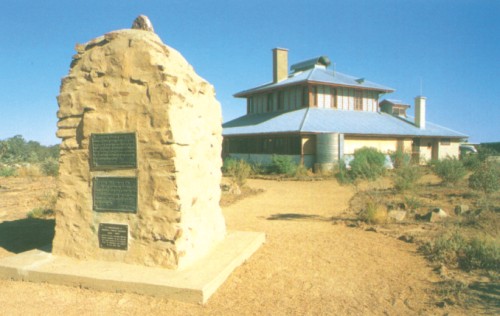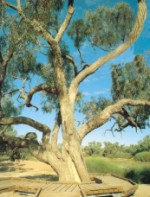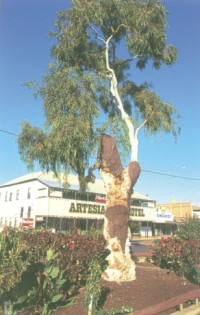|
Reflections
Curiosities
of Queensland's Outback
Fayza
Haq

If
one wished to study the life of settlers in Australia, Queensland
has its treasure trore of historical sites that one has read
about in books. In this context falls Barcaldine Shearers'
Strike Camp, Lagoon Creek. In the late nineteenth century
there was a great confrontation of labour and capital here
in Queensland. As a result, seasonal workers and trade unionism
flourished. A sense of camaraderie developed between the shearers.
When non-union labourers came from the south this led to a
massive organised strike. A tree was painted with the words
'United we stand. Divided we fall.' This strike unified the
labour movement, and was a key event in forming the Australian
Labour Party.
Another
worthwhile curiosity is the Qantas Founders outback Museum,
which has links with the international airline Qantas. This
was established in 1920 and the company soon shifted to a
more central place to Longreach. By 1921, the first hanger
was built here. The hanger, with its steel frame and concrete
floor used in World War II and till 1996 is now a museum.
The Longreach
Masonic Lodge, with its white Grecian pillars is certainly
another remarkable site to see. The Masons are a religious
order dating back to the Middle Ages. This was the home of
US Air Force pilots who took part in World War II Battle of
the Coral Sea.
 There
is then the Waltzing Matilda Centre, which is the only place
in the world that is dedicated to a legendary song, an unofficial
national anthem of Australia. Along with hi-tech lighting
effect, piped music and superb fancy innovative displays.
The residents of Winton, where this is situated in, formed
a historical society in 1977, to usher in revenue apart from
income from farming. The centre, opened in 1998, is of world-wide
interest. An enormous statue of a Swagman done by Queensland
sculptor Daphre Mayo decorates the place and celebrates outback
history. There
is then the Waltzing Matilda Centre, which is the only place
in the world that is dedicated to a legendary song, an unofficial
national anthem of Australia. Along with hi-tech lighting
effect, piped music and superb fancy innovative displays.
The residents of Winton, where this is situated in, formed
a historical society in 1977, to usher in revenue apart from
income from farming. The centre, opened in 1998, is of world-wide
interest. An enormous statue of a Swagman done by Queensland
sculptor Daphre Mayo decorates the place and celebrates outback
history.
Yet another
mark in the Australian heritage is the Combo Waterhole. This
is the place with its picturesque trees that inspired the
local poet Andrew Paterson to write poems and songs of national
importance like "The Man from Snowy River" and "Waltzing
Matilda." Paterson wrote under the pen name "The
Banjo" and he wrote his pieces in memory of a station-hand
who was involved in a protest of the ill-treatment of an Aborigine.
The music for "Waltzing Matilda" was provided by
Mary Cowan. A copy of the song was circulated around Australia,
with every packet of a popular brew, called "Billy Tea,"
and helped to make the song well-known. This was in the early
20th century.
 For
those interested in years and their mining, Opalton Opal Field,
which flourished since the 1890s should be of importance.
With increase of horse fodder and water, the settlement spread
and artmen soon boasted two hotels, numerous stores and a
police dept. With the widening of its airstrip in 1970 came
the end of the settlement. Today there are only the remains
of a bakery and the police station site along with a graveyard.
Big tree trunks mark the actual site of the opal mine. Talking
of mines, the Mount Isa Mines produce copper, silver lead
and zinc in close proximity, and is one of the few places
on earth where such a phenomenon exists. Today their daily
output is 39,000 tonnes of ore. For
those interested in years and their mining, Opalton Opal Field,
which flourished since the 1890s should be of importance.
With increase of horse fodder and water, the settlement spread
and artmen soon boasted two hotels, numerous stores and a
police dept. With the widening of its airstrip in 1970 came
the end of the settlement. Today there are only the remains
of a bakery and the police station site along with a graveyard.
Big tree trunks mark the actual site of the opal mine. Talking
of mines, the Mount Isa Mines produce copper, silver lead
and zinc in close proximity, and is one of the few places
on earth where such a phenomenon exists. Today their daily
output is 39,000 tonnes of ore.
Another
spot of historical importance in the outback is the Burke
and Wills' Dig Tree at Cooper Creek. This commemorates Burke
and Wills exploration crossing Australia from South to North.
Many people in the team consisting of a naturalist, botanist,
surveyor, meteorologist, artist and geologist died in this
fateful venture. The dig marks a memorable depot-camp in 1860
and draws a crowd of 10,000 tourists a year.
Partly
wild and still formidable, western Queensland has quite a
collection of moving historical places, with its eight heritage
trails, including Matilda Highway Trail and Opal Fields Trail.
Copyright
(R) thedailystar.net 2004
| 